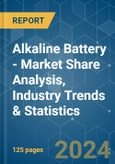The Alkaline Battery Market size is expected to grow from USD 7.8 billion by the end of this year to USD 11.47 billion after five years, at a CAGR of 8.03% during the forecast period (2024-2029).
This product will be delivered within 2 business days.
Key Highlights
- Over the medium term, high energy density, the more significant shelf life of alkaline batteries, their ability to operate at high temperatures, and their ease of recycling than other batteries are likely to drive the alkaline battery market.
- On the othher hand, the increasing competition from lithium-ion batteries having more energy density is expected to restrain the alkaline battery market.
- Nevertheless, due to their affordability, the growth of consumer electronics such as microphones, smoke alarms, flashlights, remote control, etc., demand for alkaline batteries, and single-usage entails an opportunity for its market to grow.
- Because of its increasing demand for day-to-day consumer electronics, Asia-Pacific is expected to be the fastest-growing market for alkaline batteries during the forecast period.
Alkaline Battery Market Trends
Consumer Electronics Expected to Dominate the Market
- The primary alkaline battery also is known as disposable consumer batteries; owing to the numerous advantages of primary batteries, such as low cost, and wide applications across consumer electronics such as flashlights, calculators, clocks, and smoke alarms, the demand for primary alkaline batteries remains high, worldwide.
- Due to pent-up demand, policy initiatives, and premiumization scenarios, the consumer electronics & appliances segment is expected to surge in 2023 as firms plan to expand their capacities after combating the pandemic and introduce smart-age products. This could generate the requirement for alkaline batteries in the market.
- In 2023, Canon, as a part of the company's marketing strategy and to improve its market standing, the company declared to roll out the digital camera with improved functionalities soon in a bid to cater to the demand in the digital industry. This increase in the sales and utilization of digital cameras might increase the demand for alkaline batteries in the future.
- In 2022, the global military expenditure was approximately USD 2181.92 billion, which was higher than what countries spent in 2021, and increased by 3.7%. The rising demand for primary batteries in military applications and increased demand for consumer electronics are expected to drive the growth of the primary alkaline batteries segment.
- Moreover, many countries add electronic gear to their armies, such as torch lights, night visions, etc. This equipment will likely use primary alkaline batteries for their proper functioning, thus driving the market for alkaline batteries.
- Hence, the primary segment will likely be the largest in the alkaline battery market during the forecast period due to the above points.
Asia-Pacific Expected to be the Fastest-Growing Market
- The Asia-Pacific region is in a transitional phase of moving away from carbon-zinc batteries to alkaline batteries. Many of the population that use day-to-day household appliances such as clocks, remote, etc., mainly uses alkaline batteries because of their low costs and safe disposal. Such trends are expected to increase the utilization of alkaline batteries in the region.
- Moreover, the manufacturers of alkaline batteries are focusing on expanding their business in developing countries. They are looking for growing market opportunities, which include the launch of new, low-cost products in the regions. These products are likely to drive the alkaline battery segment.
- Alkaline batteries are quite environment-friendly and can be easily recycled. It has been noted that almost all the batteries made by the major manufacturers are mercury-free and hence, do not pose any environmental pollution or hazard on disposal. This creates a buoyant demand for these batteries in Asia-Pacific since other rechargeable consumer batteries must be appropriately collected and recycled.
- The countries in the region, such as China, South Korea, and Japan, are slowly holding a significant share in the manufacturers and supplying alkaline batteries globally. In comparison, countries such as India and Indonesia are substantial users of alkaline batteries in the region. Also, in 2023, the reduction in inflation is expected to impact the growth of consumer electronic goods markets in countries such as India, Indonesia, and Malaysia, which is anticipated to increase the development of the Alkaline battery market.
- Hence, owing to the above points, Asia-Pacific is expected to be the fastest-growing market for alkaline batteries during the forecast period.
Alkaline Battery Industry Overview
The alkaline battery market is moderately fragmented. Some of the key players in this market (in no particular order) include Panasonic Corporation, Duracell Inc, VARTA Consumer Batteries GmbH & Co. KGaA, GP Batteries International Limited, and Energizer Holdings Inc., among others.Additional Benefits:
- The market estimate (ME) sheet in Excel format
- 3 months of analyst support
This product will be delivered within 2 business days.
Table of Contents
1 INTRODUCTION
4 MARKET OVERVIEW
5 MARKET SEGMENTATION
6 COMPETITIVE LANDSCAPE
7 MARKET OPPORTUNITIES AND FUTURE TRENDS
Methodology

LOADING...










